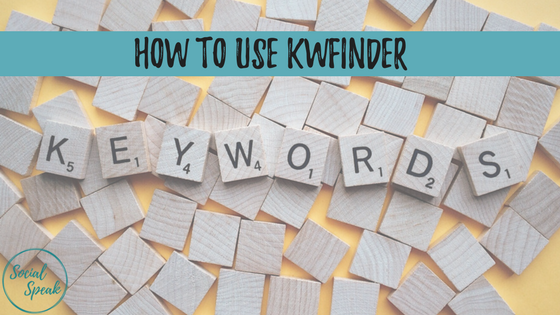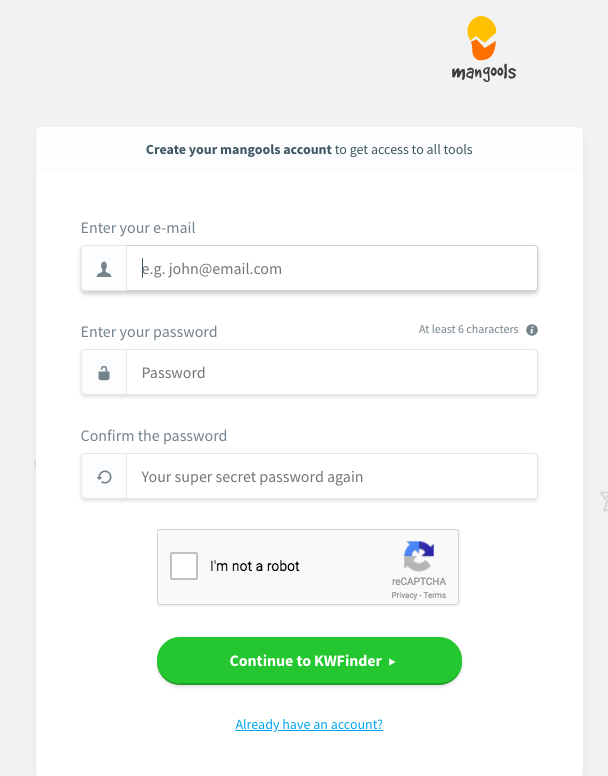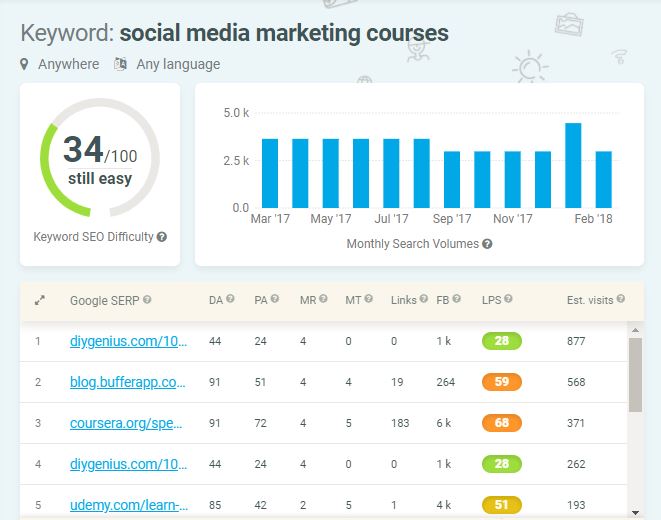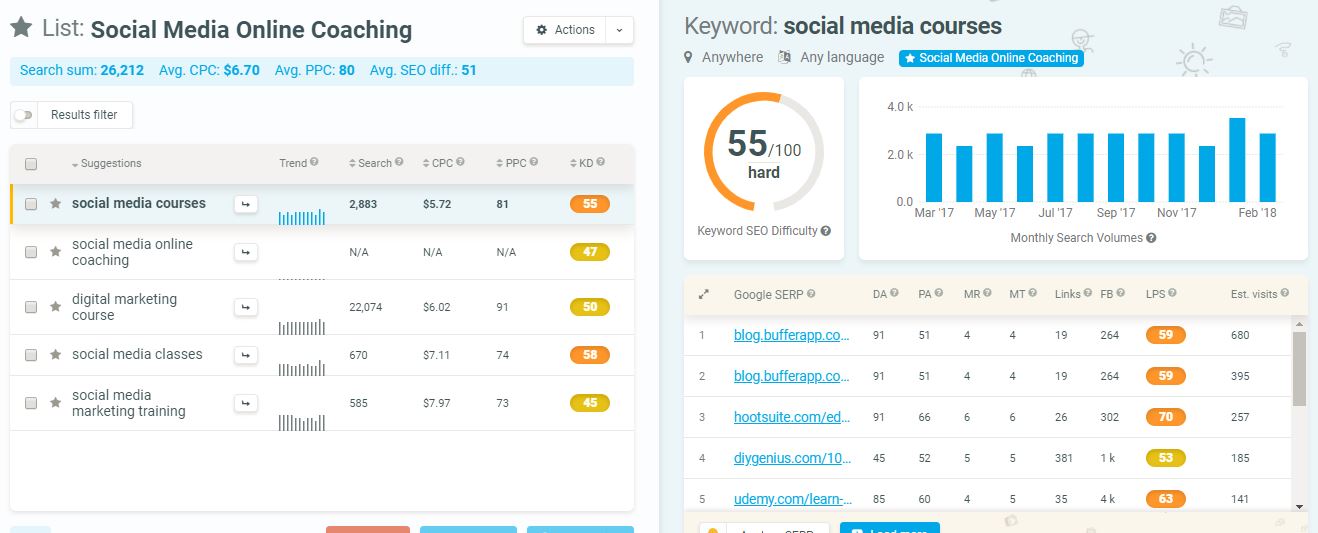In this video I take a look at how you can find related keywords on Google to boost your position in search results.
We spoke briefly last week about KWFinder and how easy it was to find the correct keywords for your business. Knowing your keyword phrases, also known as long tail keywords will help you create that strategy for your blogging and SEO. Keyword Finder is a powerful tool to help you discover your niche keywords.
KWFinder helps you discover that sweet spot with keywords that many people are looking for but have a low competition level, meaning it would be easy to rank higher on Google for those mid to lower keywords.
The one thing I love about KWFinder is it simple and easy to use. For someone like me who is such a visual person I love the how they show you all the data you need, the ranking, what other sites are using those keywords and what their domain and page authority is. This tool takes the complexity out of keyword research. Be your own keyword expert!
First Step with KWFinder
This is a free tool, but you are only allowed to have 3 FREE searches per day. First thing, create an account here. If you really want to take your SEO and blogging to the next level and really want to dive deep into finding your long tail keywords, I would suggest looking at their monthly or annual pricing. After your 3 free searches, you will have to either upgrade your plan or wait 24 hours.
The second Step Start Searching for Your Keywords
It is very simple, on the homepage of KWFinder there is a box that says “Enter Keyword” this allows you to search for the keywords you think are important to start with. You can also choose a specific location and language. If you are a local business then the location option would be very beneficial for you. When you are local you want to know what your community is searching for to make sure you re providing them the correct information. Or even if you sell online but only is the U.S. that is something to think of as well. Some of you may be ahead of the game already and have a list of keywords, maybe from an old website company, coach or just your own research, you can upload those into KWFinder, it has to be a CSV file.
One thing to remember or be aware of when you are using the location feature when you type in your keyword and the location you are wanting to search you would then click find keywords and KWFinder will show your results on a single screen. It will then display all sorts of data for you, such as the difficulty level of being able to rank for that keyword, cost per click (CPC), search volume.
The Third Thing, What does this all mean?
How hard it is to rank for that specific keyword. You will see green, yellow and orange buttons with a number in them, ranging from 15-63 or even higher. This is really important for your strategy. If the keyword is in orange which is usually over 45 that means it is going to be very difficult to rank on Google for that keyword. Your strategy at this point should be looking for the yellow and green keywords. KWFinder shows you different keywords that are similar to the one you searched for, it is also going to tell you how many people a month are searching for that keyword or long tail keyword.
For example I searched “Social Media Online Coaching” the ranking was 47 which is yellow meaning it is possible for me to rank on Google with that keyword, but if I wrote about “Social Media Monitoring” which is a 32 it would be easier for me to get on the first page of Goole or other search engines with that long tail keyword.
Here are a few things below that each search will provide you:
* What’s trending
* Monthly Search Volume
* Cost-Per-Click (CPC)
* Pay-Per-Click (PPC)
* Google SERP results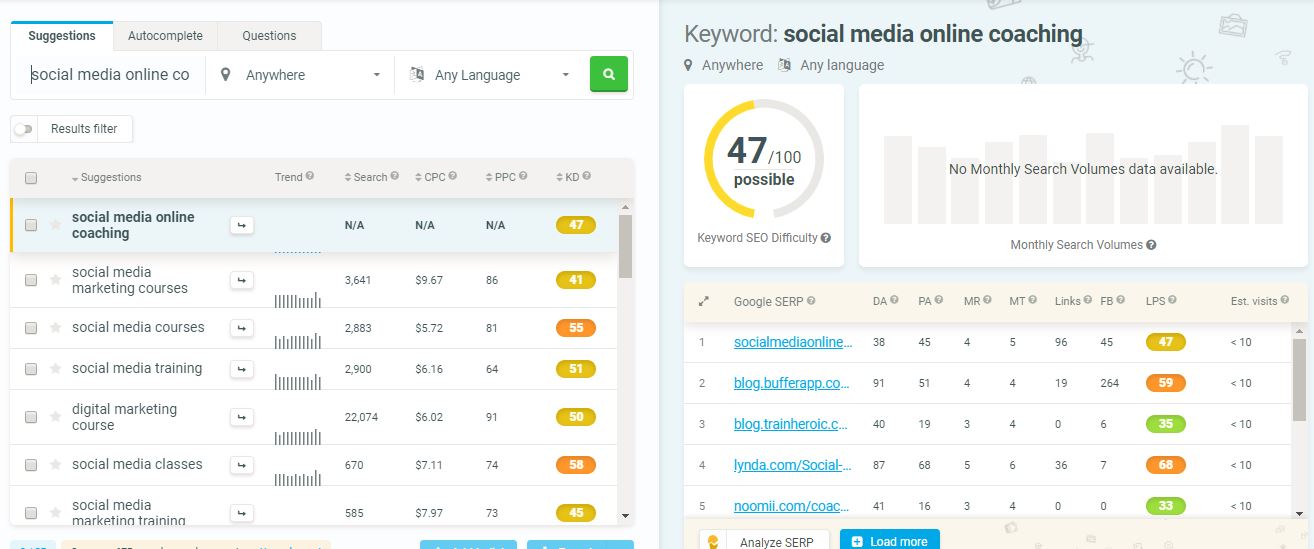
SERP Competition Checker
Get localized Google SERP results with KWFinder. The SERP checker is a Google SERP competitor analysis tool providing 45+ SEO metrics. (SERP= Search Engine Results Page)
Another feature to look at when look at your keywords, on the right-hand side of the dashboard it will show you what websites are using those words and what the competition level is, the green, yellow or orange rankings. It will also display on each website their DA (Domain Authority) and their PA (Page Authority).
Domain Authority (DA) is a search engine ranking score developed by Moz that predicts how well a website will rank on search engine result pages (SERPs). …Domain Authority is calculated by evaluating linking root domains, the number of total links, MozRank, MozTrust, etc. — into a single DA score.
Page Authority (PA) is a score developed by Moz that predicts how well a specific page will rank on search engine result pages (SERP). Page Authority scores range from one to 100, with higher scores corresponding to a greater ability to rank.
Creating Your Keyword Planner
Once you have found the keywords and long tail keywords you want to use, you can create a list within your KWFinder account that you can save to help you manage your search efforts. You may want to think of different lists, categories of your keywords. For us, we may have a list that is “Social Media” and one that is “Digital Marketing Tools” the important reason about having different keyword lists is you will be writing different content on your website, think of the services you offer and how you can write blogs all around those different topics. Those are the keyword lists you need to create.
How to create a new list:
- Select the keywords you want to add to a list
- Then you will see “Add to List” click that button
- Then enter your list name
- And DONE!
This saves the list to your account, you can always add and delete keywords from that list as you need to. You can also download your list into a CSV file if you would rather do that. One thing to always remember when adding your keywords to your list, it is better to add the easy (green) and mid (yellow) to your list rather than hard (orange).
WrapUp
This amazing tool provides you a ton of powerful information to help you succeed with your SEO and Blogging strategy. In today’s digital marketing world it is important to always stay abreast of the hottest topics and trends in your industry and become even more of an expert than you already are. By utilizing KWFinder and all of its bells and whistles you will be able to find those relevant long tail keywords for you and your business, taking your digital marketing to the next level. This is an efficient way to stay on top of those trends and searches and will save you a ton of time in the long run!
Interested in learning more? Take a look at these articles:
As technology continues to evolve, it may come as no surprise that the marketplace has become increasingly digital. In an attempt to capture a growing and lucrative online marketplace, business owners are beefing up existing marketing efforts with digital marketing strategies. They are doing everything they can to keep up.
Here are 3 ways digital marketing can help grow your business.
Connects you with mobile consumers
Whether you’re managing an e-commerce business or a brick and mortar store, it is important now more than ever to have a solid online presence. According to studies, 72% of consumers are already connecting with brands through their various digital marketing channels.
Having a strong online presence makes it easier for potential customers to find you. Remember, your competitors are working hard to build an online presence. If people can’t find you online, then they are likely to come across your competition.
Generate more sales
Thanks to the internet, almost everything can be done on a smart phone. It allows you to communicate with your family and friends, keep up to date with current events, do research, and even go shopping.
In the age of digitalization, more and more people prefer to shop online than visit the local stores. After all, online shopping is more convenient. Plus, all the items your purchased will be delivered right at your doorstep. With the increasing popularity of online shopping, it is important harness the power of online marketing. Not only will it get your products and services in front of potential customers; it can also help you generate more sales.
Allows you to compete with large corporations
Not too long ago, big businesses would put up billboards and create TV commercials in the hopes of reaching their audience. While there is no denying that such methods are effective, they can be too expensive for small business owners.
With digital marketing, small business owners and marketers can get the word out about their business without having to spend a huge sum of money; thus, allowing them to compete with large corporations. Since majority of their target audience is already spending most of their time online, online marketing provides a quick and easy way to reach your target audience.
SEO Myths You Should Leave Behind in 2017
SEO is always changing and evolving. With this continuous change, a lot of marketers and business owners are left in a state of constant adaption.
Thanks to the internet and blogs, it is easier now more than ever to share information. A lot of people want to share their knowledge with others. Unfortunately, not everything you read on the internet is true. Often, false ideas and wrong information gets mixed up with facts. Because of this, a lot of myths and misconceptions remain no matter how many experts debunk them.
There are lots of misconceptions about SEO that you should know about. Here are some of the biggest SEO myths you should leave behind in 2017.
Keyword stuffing is the ultimate SEO hack
Back in the early years of search engine, people used to shove as many SEO keywords as possible onto a web page to improve SEO rankings. Using keyword in your content can get your website ranked high in search engines. But overly stuffing your content with your keyword isn’t a good thing either. If you do, your content will be perceived as spam, and your site will be penalized.
When using keywords, make sure you incorporate them as seamlessly as possible into your content. Also, make sure that the keyword density doesn’t go over 5%. Otherwise, it will be viewed as spam.
Social activity doesn’t affect SEO
Google doesn’t use social metrics such as the number of shares, likes, and followers for SEO. But that doesn’t necessarily mean that your social media efforts are useless.
Each post you make will be categorized as a page. With millions of social media posts, along with other contents published on the internet on a daily basis, not everything gets indexed by Google. But when a social media post goes viral, it triggers a signal in the Google algorithm. This puts your content in front of the right users; thus, increasing engagements and driving more traffic to your site.
Social media may not directly affect search engine rankings, but it can have significant secondary effects on your SEO.
Creating high quality content is enough to rank your website
It is true that content is king. In fact, Google rewards websites that generate valuable content regularly by giving it a higher ranking in the search engine results page.
While creating well-researched and relevant content is a great starting point, it’s not enough to get you to the first page of Google. It may be impossible for crawlers to find your content if your website isn’t optimized.
You may have a blog full of good quality content and you make it a habit to publish a new one every week, but there is no point in writing great content if no one is aware of your work.
Ahh! Run for the hills, blogging is dead!
Wait, what? After all this work blogging every day for 2 months, I’m now saying blogging is dead? Let’s step back a moment.
There is always someone talking about social media being dead or blogging being dead, but the truth of the matter is that even if one strategy isn’t working as it used to, another strategy jumps in and takes its place.
Let’s take a look at blogging.
[Disclaimer: I do not think blogging is dead. It has absolutely changed in the past year or two years, but doesn’t everything shift, change, and get better over time?]
In 2015, Hubspot reported ideal blog lengths. The report stated that:
- Shorter is better for blogs. In fact, Forbes even published an article stating “After 750 word — or sometimes after only half that — you risk losing your readers’ attention.” [Source]
- Most posts on WordPress were only 280 words long.
- In general, however, for this short blog post strategy to work, you needed a large network and needed to post frequently. In essence, your blog feed started looking more like a social media account news feed.
- Around this time, articles also started popping up that stated blogs under 750 words received the most shares, whereas blogs over 1,200 or 1,500 words ranked the highest organically.
Blogging in 2016
As the months passed, this shifted drastically! By early 2016, it started becoming clear that not only was content still king, but LONG content reigned top. The longer the content, the more shares and inbound links you would find. But, it wasn’t just articles 1,500 – 2,000 words long. We were now talking 3,000 – 10,000 words long!
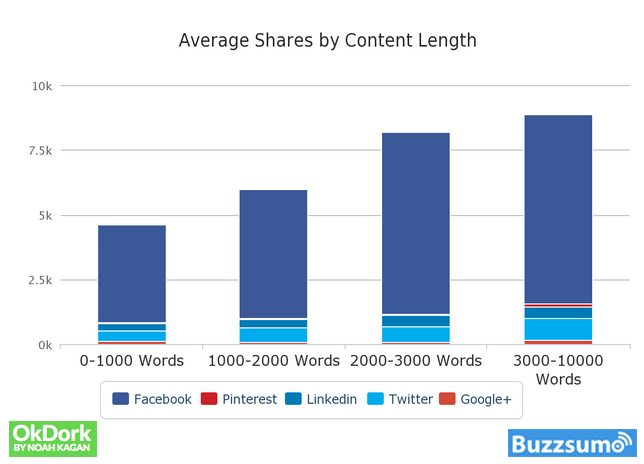
What this means is that even though in 2015 bloggers were posting short blogs frequently, they were overlooking the importance and response they could get by going more in depth in a topic. Most bloggers weren’t taking the time to go into depth about their topics. The surge in shares for pieces of content that were between 3,000 – 10,000 words went against older common sense that people would lose interest in longer articles. The truth was that these longer articles actually capture more of the reader’s attention!
Looking back at 2015/2016 it actually was that bloggers didn’t want to spend the time going into depth.
During this time, as well, Medium.com completed a study on the optimal post length to capture a reader’s attention. Not surprisingly, considering the data we’ve already reviewed, the best length was approximately 7 minutes, or between 1,500 and 1,750 words. Again, however, we see the same trend that a majority of posts on Medium represent 3 minute reads. These 3 minute reads were viewed the most frequently, because there are more of them, but the best length for engagement was at the 7 minute mark.
Total Engagement or Time on Article
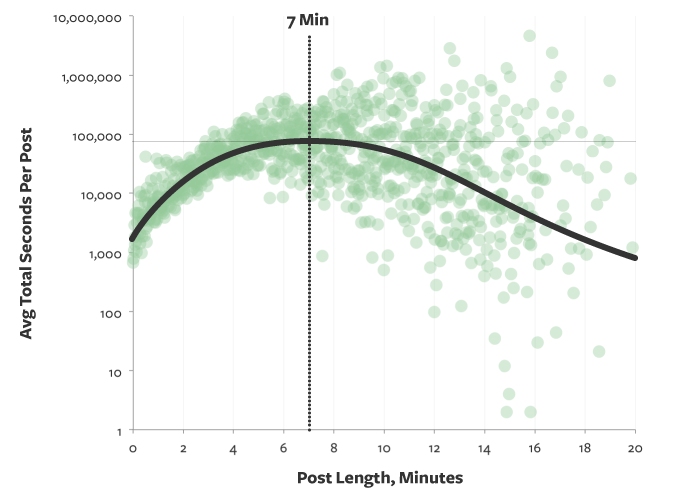
Total Views By Post Length
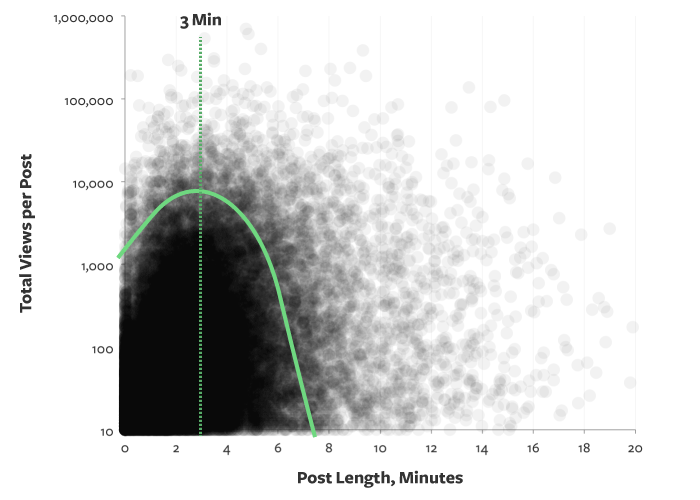
Okay, so it is pretty clear from this data that blog posts generally have been getting longer and readers tend to enjoy this longer content. We see this in not only the time people stay on a longer article, but also the number of times longer content is shared and the organic rankings of longer content. This is still all in the past, however!
Let’s jump to 2017, what can we do now to make the optimal blog post?
Researchers are still pointing at longer blog posts and unfortunately tend to reference older data to stake their claims. There are, however, some incredible insights about what this data now means!
In 2017 long form blog posts are where you need to be. It is more difficult for some people to create this content than others, but if you are hoping to use blogs for SEO and to appeal to clients, you need to make sure that a majority of your blogs are over 1,500 words and at least a few blogs every month are in the 3,000 to 5,000 word range.
Why is this?
As you write more in depth on a topic, you are utilizing more related keywords. Google and other search engines are able to pick up on these related keywords and understand the topic you are talking about more clearly. Think about it… the longer your content, the more words you use, and the more likely the words you are using relate to one another.
You want to be mindful about these related long tail keyword phrases you are using.
One way to double check your work as it comes to long tail and related keywords is to simply turn to Google.
Let’s say your keyword was Search Engine Optimization. Type this into Google. The text box automatically pulls up other keywords people often search for. Here we see definition, how to do, techniques, etc.

These words and others also appear at the bottom of the search results page. Just scroll all the way to the bottom and you will see a section titled “Searches related to search engine optimization”.
How to use Related Keywords
Each of these words can make great long tail keywords to include in your content. You can also get a sense of what spin you should take in your writing. Are people looking for how to’s and tips or for more informative background or even specific products relating to your content?
Include media embedded in your longer blogs to make them more shareable.
Longer pieces of content also tend to have more media inserted. Blog posts with at least one image tend to outrank and be shared more than those with no image.
When you have a longer piece of content, you also have more opportunities to insert images, videos, and podcasts. Each of these then may appeal to one individual or another. Take the time to build graphs, infographics, and other imagery that can help your content stand out.
Internal and External Links in longer blog posts for SEO
Additionally, writing longer content creates more opportunities to increase your internal linking and provides more incentive for external websites to link to your content. As you are writing, you are showing your expertise and knowledge on your subject. As you write, be sure to add links to other blog posts you’ve written. These longer blogs also create an opportunity for yourself to then highlight an eBook or freebie on your site.
Longer blogs create prompts for additional content on your site.
Often times, a longer blog post actually works very well as a starting point for your marketing for webinars and products. When you write the blog you are cultivating the information that can then be shared through different avenues. You are better able to repurpose your information that appears in the blog post.
To repurpose content, start with your blog post. This information can then be expanded upon in an eBook, which can be used to collect email addresses. Your email newsletter then in turn works as an avenue to share additional blog posts that are on information related to the eBook.
From here, you can measure which topics get the most response from your own market. These topics that get the highest engagement rates, then provide the basis for more in depth blog posts, eBooks, webinars, and finally products that you can sell online (or in person). Each blog post should also be shared on social media, as LinkedIn articles, and through sites like Quora and Medium.
Through repurposing the content you are building even more links between pages and reaching even more individuals.

Lastly, we need to look at where the industry is heading.
In the future, I don’t think studies of blogging will only measure effectiveness based on how many words appear in an article. Recent trends show that it is becoming increasingly important to include video and audio in blog posts. My hypothesis is that the research on blogging effectiveness is going to shift to measure the effectiveness of having these more personal elements. This unfortunately means a lot of us are going to have to step out of our comfort zone!
If you take a moment to consider how we choose to work with certain businesses and individuals, it really boils down to us knowing, liking, and trusting the person. Video is such an incredible way to tell people who we are and to show our personality.
As a Recap
- In the past, shorted blogs worked well for business
- Businesses and bloggers still tend to write these shorter posts, but need to dive into more detail
- To run an effective blogging program, you need to write posts that are 1,000-5,000 words long
- In these long posts, be sure to include Related Keywords, link to other blogs on your site, and share the posts to your other networks and email list
- Base eBooks and freebies on your site on content repurposed from your long blog posts as a way to manage your time more effectively
- Start stepping out of your comfort zone and include audio and video in your blogs posts in addition to images and infographics
Apparently, Google uses about 200 factors to rank a site. This can seem intimidating for those who just launched their website and are looking for ways to improve their search engine ranking. But here’s the catch. Not all of these factors do affect your SEO ranking. In fact, some of them are nothing but speculations.
As a business owner and digital marketer, it pays to pay attention to the things that really matter.
Here are 4 factors that do not directly affect your search engine ranking.
Social media presence
We all know how powerful social media is in reaching out to your audience. We’ve seen several articles circulating online suggesting that social media is the new SEO. While social media can help drive traffic to your site, it does not in any way affect your search engine rankings.
Let’s say your blog post garnered 20,000 Facebook shares. This will help increase your online presence, brand awareness and even boost your site traffic, which is a good thing. Social media can help your business in a lot of ways, but boosting your search engine ranking isn’t one of them.
Repetitive use of keyword
Most people would use the keyword throughout the content in the hopes of improving their search engine ranking. It helps to incorporate the keyword into your content as seamlessly as possible. However, overusing organic keywords can be a bad thing.
The goal of creating content is to attract readers. Google will reward your site if you publish good quality, informative and relevant content. But if you try to incorporate too much keyword into your content, your articles may end up painful to read. Your content will suffer. This can negatively affect your SEO ranking.
Paid advertising
A lot of people think that they’d rank better in search engines, Google in particular, if they carry Google Adsense Advertising. This makes sense given that Google would make more money when people click the ads. But that’s not how it works.
While paid advertising can help drive traffic to your website, it doesn’t have a direct impact on your search engine ranking. The decision not to use Google Adsense will not harm or hurt your rankings.
The age of your website
Google doesn’t really care whether you built your website in 1999 or in 2016. The only thing Google cares about is how your content helps people. If you built your website more than a decade ago and it’s still running up to the present time, chance are you’ve already built a lot of authority, links, and equity.
Just because you created your website 2 years ago, it doesn’t mean that the older site would perform better. If you have reached the same status and have built the same authority, links, and equity, there’s a good chance that Google would reward your site even more. Why? It’s because you achieved all that within a short period of time.

This post was originally published on Moz.com. Welcome to the sixth installment of our educational Next Level series! In our last episode, Jo took you on an adventure diving for treasure in the long tail of search. This time around we’re answering the call for help when you feel like you’ve done all you can, but you’re still not ranking. Read on and level up!
You’ve optimized your pages, written delightful title tags, concocted a gorgeous description to entice clicks, used your target keyword in your copy with similar words, and your content is good, like really good. As far as you’re concerned you’re doing everything you can on that page to say to Google “This is relevant content!” But, lo and behold, you’re not ranking.
Frustrating, right? Well, no more. I’m going to show you how you can discover what’s holding you back, and how to make sure your site is a lovely big target for visitors, just like this happy fellow:

You’ll learn some tricks you can do in your browser and then we’ll speed things up with some cat magic and pixie dust to sprinkle all over your site.
To start, pop open these tools in another tab so you’re ready to go:
- Campaign deliciousness in Moz Pro (if you don’t have it set up, take the free trial for a spin to follow along)
- Your pot of keyword gold
Dreamy!
Step 1: Put in a quick call to Google
Well, you could try to call Big G (that’s what I like to call Google sometimes, just for kicks), but you may have better luck phoning yourself from 1995 with the idea for Google — then you could fix the rankings in your favor. Totally worth it.
Hello, operator?
Instead of messy and possibly future-altering time travel, you can put a call in by running a search operator like this:
site:yourfabsite.com
site:yourfabsite.com/blog
site:yourfabsite.com/blog/my-site-rocks
It’s like saying, “Hey, Big G, show me all the result you have in your index for yourfabsite.com.” This is what you don’t want to see:

If you’re seeing the above, you won’t be able to rank because your site isn’t indexed. It’s got to be indexed before it can rank, and it’s got to be crawled before it can be indexed. Trying to rank without being indexed is like applying for a job and forgetting to attach your CV.
Search Console is here to console you
In the results page above, Google is directing you straight to the Google Search Console.
Not quite as fun as Xbox or as comforting as a hug from a loved one, Google’s Search Console is still pretty sweet all the same.
Go — right now, right, right now, don’t read any more, you should have already gone — go and set up your Search Console. Once you’re all set up and your site is verified, you can go to the page that I like to think of as the Fires of Mount Doom and throw in your precious.
https://www.google.com/webmasters/tools/submit-url
Don’t worry, that analogy doesn’t hold up. It won’t destroy your site. 🙂
Head to “Google Index” and then “Index Status” to see the data similar to what we looked at above, but in graph form! Definitely handy for tracking how your pages have been indexed over time.

If your site is not being indexed, you’re going to want to take a closer look at your robots.txt file. Check your Search Console Messages to see if there’s a reason Google couldn’t index your site. If Google can’t access your robots.txt file they’ll stop indexing to avoid crawling pages listed there.
Toolkit:
Google Search Console – Find out why you’re not being crawled and indexed
Further reading:
A Beginner’s Guide to Google Search Console
How to check which URLs have been indexed by Google using Python
Step 2: Find out where you’re ranking
Now that you know your pages are being crawled and indexed, you want to get them to the top of the results where they gosh-darn-well should be, right?
Find your rankings with your bear hands
Yes, I DO mean bear hands. This is a manual job and your soft, tender, indoor keyboard hands just won’t do. So attach your bear hands and start digging. Search Google for your brand name, primary keywords, secondary keywords, words, and phrases you used on your page (one at a time, of course). Feel the ache in your chest as you scan the page: “Where is my jazzy title? My tantalizing description? My adorable URL?”
Turn up the volume
Not finding your site on the first page? Instead of clicking through to the many ooooos of Google, we’re going to change the settings in your browser to show 50 or 100 results per search so we can view more results with every search. I’m going to want to see A LOT more pet costume results, so I’ll click on the gear icon in Chrome and hit “Search Settings,” then toggle up the “Results per page”:

Now we’ve got a whole page of 50 or 100 results to search through. Use CMD + F for Mac (or CRTL + F for Windows) to search for your domain.

This process is great for doing a quick check to see if you’re in the top 50 or top 100. Remember that your browser can return personalized results when you’re logged into Google, so log out and enter incognito mode.
Like any good detective, make sure you record the keyword, position, and URL in a spreadsheet for Future You to discover and applaud Present-Day You on your fabulousness.
Start cooking with gas
Manual searches aren’t for everyone. I mean come on, we work in technology — we don’t want to be lugging keywords around the hot, dry Google search page, plugging them in one after another. I hear ya buddy, loud and clear. Let’s detach those bear hands, grab your list of keywords, and plug them straight into Keyword Explorer.
Check if you’re on the first page
Remember, you’ll need a Medium or higher Moz Pro subscription or a standalone Keyword Explorer subscription so you can create your keyword list.
Hit “Create or upload a new list” and choose “Enter Keywords” to pop those straight in there, bish-bash-bosh.
Open up a list you’ve created and pop in your URL to to see your rank from 1–10.

Want to see if you’re in the top 50?
Heck yeah! Take that same list and paste them into a new campaign in Moz Pro.

If you already have a campaign running you can also transfer these straight over from Keyword Explorer. Just check the box next to the keywords you want to track, then choose a campaign from the drop down.

You know before (about 30 seconds ago), when we talked about manual searches returning personalized results? Checking rankings in Moz Pro avoids all that nonsense by anonymizing the data and, in my experience, provides the most accurate results, showing what the “most” users see. Pretty snazzy, right?
A new campaign will build in about 30 minutes, which is just enough time to catch up on “Stranger Things” and reminisce about Winona Ryder circa 1990…
On the other hand, adding to an existing campaign will be a bit longer. You’ll see data as soon as your campaign updates next. So you can binge watch the whole series, because why not, right?
…and we’re back! Check out where you’re ranking for your target keywords, which URL is ranking, and over time, whether you’ve moved up or down.

We also pull in search volume from Moz’s Keyword Explorer to give you an idea of demand. When looking at search volume, don’t forget that the higher the demand, the more competition you’ll likely face. Don’t be disheartened by ranking well for keywords with lower search volume, especially if they convert better.
Tracking your rankings is crucial to understanding why you’re not performing as well as you expected. If you’re seeing a lot of down arrows, you need to investigate who is jumping ahead of you and why.
Dig into keywords with falling rankings
Let’s find some keywords that have that sad little down arrow, meaning we’ve dropped down in rankings since our last update.

Here’s a little bundle of keywords that I can investigate. I’ll click on the keyword to open up the Analysis report and scroll down to “Your Performance.” Now we can see a historical graph of your rankings and track those other sites who want to push us to one side. And what do we have here?

They’ve gone and nipped in front of us! This will not stand! It’s likely that for some reason your competitors result has been getting stronger engagement for this keyword. More clicks and more people who do click staying on the page. So let’s find out what you can do to set things right.
Toolkit:
Keyword Explorer Lists – Check your rankings on the fly
Moz Pro – Track your rankings (and your competitors’) over time
Step 3: Make sure you and your content are best friends
There are 2 parts to this step, just like those ‘Best Friend’ heart necklaces that were so popular in the ’90s. Separately they look like BE FRIE and ST NDS, but together…. awww, the secret code is unlocked.
| Get your basic on-page optimization in order. |  |
Check your content is tip-top quality |
Don’t go changing (too often)
I don’t want to recommend you jumping in and making changes to content too often. Even Google needs time to register your updates. However, if your content is a bit dusty and you’re losing out to competitors, then it’s time to check that everything you think is in place is actually in place.
View your page like a bot
I like to think of this as a “bot’s-eye-view.” When a little bot comes along, it doesn’t go, “Oooh, look at that lovely header image! Oooh, I love that font, the white space is really working for me! Oh, how the Internet has changed since my days as a junior bot trawling through gifs of dancing babies!” It reads the code and moves on. We can do this too, with a little bit of knowhow.
Using Firefox or Chrome, you can right-click and view the page source.

If you’re unfamiliar with reading code, it’ll look pretty intimidating.
We’re going to use CMD + F (or CRTL + F for Windows) to hunt for the bits and pieces we’re after.

Pro tip: If you’re seeing og:title, this is a Facebook tag.
Likewise, if you’re using the meta property=”og:description,” this is also a Facebook tag. These help format posts when the URL is shared on Facebook. You’ll want to make sure you also have Title and Description tags link these:
<title>The best title for this page</title>
<meta name=”description” content=”The best description for this page” />
Basic page optimization
This is relatively straightforward because you control your pages. However, maybe for that very same reason, it’s still a bit of a stumbling block for beginners. I’ve been there. I once spent a whole morning trying to write a single title tag.
If you’re confused and locked in a mind-melt of madness because you can’t figure out if you should use the primary keyword and/or the secondary keyword in the title tag, chill your boots.
Here is a brisk and fairly brief run-through on how to get into a productive page optimization mindset.
Title tag basics
This is the bit you click on in the SERPs. Should be about 55 characters of punchy goodness that is relevant to your content. Because it’s relevant to your content, it includes the words you want to rank for and accurately describes what you’re talking about. You better believe Google is paying attention to click signals, so draw that click with your awesome headline. Think about the titles youclick on when you’re searching for lovely things. Do your own searches to see what title tags are out there; it’s not like they’re hard to find, they’re literally a click away.
Description tag basics
This is the bit of text under the title tag in the SERPs. They should be about 155 characters of tender lovin’ poetry that talks to the user like they’re a real human being, because they are, and so are you (unless you’re part of the cat colony I suspect controls large portions of the web). This is not a direct ranking factor, but it can heavily influence clicks. Clicks from humans. And what do clicks do? They signal to Google that you’re hot stuff!
On-page copy
Yep, you’re going to want to pop your keywords here, too. But really, let’s not get too hung up on this. If you’re writing something super-duper about your topic, this will flow naturally. Make it as long as it needs to be to make your point. Don’t rattle off the same words over and over; use language to the best of your ability to describe your topic. Remember all those clicks you worked so hard to get with your title and description tags? Well, if they all bounce back to search, you just know Google is paying attention to this. Your content has to be worth the click.
Go and look at what type of content is already ranking. This is not an exercise in scraping content, but a way to make sure that your content isn’t just as good, but much better.
This task can be done manually for a small site or for a few pages you’ve cherry-picked, no problem.
Check your whole site regularly
Maybe you’ve been creating content like a content-creating super machine and you might have skipped a few description tags. Or maybe you copy and pasted a title tag or two. In this case, you’ll want to check that it’s all hunky-dory on a larger scale and on a regular basis.
We’re going back to our Moz Pro campaign to take the heavy lifting out of this job.
Head to the Rankings tab and hit that little “Optimize” button.

Once you hit that little button, you’ve set off a chain of events where our bot looks at the keyword you’re targeting, then has a good old dig-around on your page and gives you a score out of 100.

We’re hoping for that wheel of destiny to roll around to 100.
If we make it part-way around, it’s time to look at the suggestions to see how you can improve your on-page optimization.

Focus on top-level pages, pages that convert, and high-authority pages first.
Toolkit:
Moz Pro Page Optimization – Check that your whole site is optimized correctly
Further reading:
8 Old School SEO Practices That Are No Longer Effective – Whiteboard Friday
Step 4: Become a keyword connoisseur
It’s easy to become fixated on a keyword beyond what is reasonable or healthy. Are you carrying a torch for a golden keyword? Stalking it in the SERPs even though it’s completely entranced with the likes of Wikipedia, eBay, AdWords, and Image Packs?
Ranking in the high-click zone for your keywords is all about beating other sites. This special, golden ticket to traffic wonderland might be a good long term goal, but you’re not going to get to the top of the results in the near future.
On the other hand, maybe you’re afraid of competition, so you only target keywords with very low difficulty.
This can be a winning strategy if the keywords have strong intent and you’re targeting the long tail of search, but you don’t want to put in all that work creating content and find that no one is searching for it. No searches means no traffic, and no traffic means no humans to click a thing that makes a person somewhere in the world look at their analytics data and smile.
A little bit of competition is a good thing — it indicates a healthy, profitable industry.
So we’re looking for a sweet spot: keywords with some demand and less competition. I’m going to break down what organic competition is, and how you know what level of keyword difficulty you can target.
What’s the meaning of this so-called ‘competition?’
If you want to rank organically, your competition is the other sites that are currently on the first page for the keywords. It’s not the total number of sites that are using your keywords in their content, and it’s not the AdWords competition.
If someone on your team, or an agency or a client sends you competition data that’s defined as low, medium, or high, this is very likely to be AdWords competition, and it relates to the cost-per-click.
Moz’s Keyword Difficulty score uses the top 10 organic results to calculate the Difficulty metric. It’s a score out of 100, where a higher number means that the competition is strong, and it may take you longer to see results from your efforts. Every search you bash into Keyword Explorer shows you the Difficulty score, and you can build these into lists so you can compare related keywords.

Benchmark your site’s Difficulty rating
We know that Difficulty is out of 100, but a question we get all the time is: How do I know what level of Difficulty is too high?
Well, first off, testing is a sure way to find out. But if you want a little pointer before you head down that road, here’s how you can quickly benchmark your site’s Difficulty rating.
I learnt this tip from Russ Jones at Mozcon, so I apologies for the blatant rip-off here, but it’s too handy not to share.
Time for another consoling hug from Google Search Console. Grab the keywords that are already sending you traffic from Search Traffic > Search Analytics and download them to CSV.

Save these to a list in KWE.
I usually copy those darlins out of the CSV and plonk them right into a new list.

Hit “Save,” and now you have a benchmark to use when looking at other keywords you could potentially rank for.

When you’re looking at keywords to target in the future you’ll have a good idea whether it’s a short-term or long-term goal.
You can also capitalize on keywords you’re already getting traffic for by looking for opportunities in the SERP Features. Can you steal a Featured Snippet?
I also want to track these keywords over time to see if I’m losing or gaining ground, so I’ll add them from my list straight to my Moz Pro campaign.

Next time my campaign updates, and forevermore into the future, I’ll be keeping the sharpest of eyes on these keywords.
Toolkit:
Google Search Console – Grab keywords already sending you traffic
KWE – Find the real organic competition and benchmark Difficulty
Step 5: Build your site’s authority
Now step 5 is a real doozy, and it’s a common stumbling block for new sites. Just like networking in the real world, online authority is built up over time by your connection to sites that search engines already trust.
I like to think of authority as the pixie dust from the J.M. Barrie novel Peter Pan. It’s almost mentioned as an afterthought, but without it Wendy and the gang were just kids jumping up and down on their beds. They’re thinking happy thoughts. They might even get a bit of temporary lift, you know, just like when you might get a bit of traffic here and there — enough to keep you jumping. But there’s a very big difference between jumping up and down on a spring-loaded mattress and flying off to a world of perpetual youth.
Track your authority
To figure out how much dust you have in your tank, you’ll need to take a look at the Moz metric Domain Authority. This is our best prediction of how well a site will rank for any given search. It’s on a scale of 1–100, and higher DA means more authority.
You can get your paws on DA free through Open Site Explorer or the MozBar Chrome extension. I like to keep MozBar on DA mode so I can check this metric out as I scoot about the web.

You’ll want to check your DA monthly to see how you’re progressing and save this to a sheet, as incoming fresh data will replace the current data in OSE and MozBar. Once you’ve got your data, think about plotting a tasty graph to show how you’re performing versus your competitors.
To make this a whole lot easier, head to the Moz Pro “Links” tab. Here you’ll find your historical link metrics, alongside those of your direct competitors.

Pixie dust isn’t just powering your rankings, but everyone else’s as well. These metrics are relative with respect to the other sites similar to your own, including your competitors.
Gather a pocket full of pixie dust
The first thing we always recommend when people reach out to us to find out how they can improve their Domain Authority is to improve the overall SEO of their site. The good news for you is we’ve already done that in steps 1-4 — highest of high fives to you!
The second thing you have to do is get backlinks. This is commonly known as link building. When I started doing SEO for an ecommerce site back about what feels like a thousand years ago now, I had no idea what I was doing; this term irked me, and still kind of does. It sounds like you need to build links yourself, right? Nope! It’s like you’re playing Minecraft, but instead of building the structures, you’re actually trying to encourage other people to build them for you. In fact, you’re not allowed to build anything yourself, because that’s cheating. Game changer!
Don’t forget you don’t want just anyone building these structures. You need good people who themselves have authority; otherwise, your lovely gothic mansion might turn into a pile of rubble. (This is my analogy for having spammy links that could get your site penalized by search engines.)
A lot of link building today is PR and outreach. I’m not going to go into that in this post, but I’ll include some links in the toolkit below to help you in that department.
We’re going to look at what actions you can take to track and build your authority.
Check for any leaks
There’s no point grabbing up pixie dust if you have a whopping great hole in your pocket.
Find and plug any holes quick-smart. Open Site Explorer has a handy tab just for this job. Pop in your domain and hit “Link Opportunities.”

Now here’s a list of broken pages on your site that have inbound links. Any page on your site that’s down isn’t passing on its value to the other pages on your site — not to mention it’s a shoddy user experience. Look out for any pages serving a 404 status error. I can priorities the pages with the highest DA and more linking domains.
Internal links
I said before that you can’t build any of your links yourself. However, as with everything in SEO there’s a caveat: in this case, links from within your own site are not only key to your site’s usability, but they also pass equity. Internal linking is primarily for user experience, but it also helps bots navigate your site for the purposes of lovely indexing.
Don’t stuff too many links on your page
Your homepage and other top pages will probably have the strongest authority, as other sites will link to your homepage in many cases.
You want that high-equity page to link out to other pages in a natural way that resembles a pyramid structure. Don’t forget the user in your rush to dish out equity; do visitors want to go from your homepage straight to some random deep page on your site? Does this help them on their journey?

Use the Crawl Test research tool in Moz Pro to find out if any pages of your site are flagged for having too many on-page links.

You also shouldn’t go overboard with keyword-rich anchor text. Once again, think about the user, not about gaming search engines. This one can get you penalized in some way, so keep it natural.
If in doubt, just watch Season 2 Episode 4 of the IT Crowd for this delightful moment:

If you’re scooping up big swaths of copy to get keyword-rich anchor text but it doesn’t really help the person reading the article, then maybe you’ve got yourself an awkward link at your dinner party.
To follow or nofollow?
Links come in two flavors: follow and nofollow. Generally speaking, you do want your internal links to be “follow.” Bots will follow them on the journey of your choosing and equity will be passed on, which is just what you want.
You can use the MozBar to check your pages for follow and nofollow links.

Nofollow links can be marked on a link-by-link basis, or a whole page on your site can be allocated as nofollow. Let’s find the “Meta-robots Nofollow” column in your crawl CSV and filter by TRUE to check if you intended to mark these pages as nofollow.

Convert mentions to links
If people or sites are already talking about your brand, then you’re not a million miles away from converting that to a link.
What you’re searching for are pages that mention your brand term but don’t link to you yet. This takes a bit of digging to do manually, but thankfully this is automated in your Moz Pro campaign.
Head to the “Links” tab in Moz Pro and hit “Opportunities.”

If you’re not seeing suggestions, you’ll want to modify your Brand Rules (Rankings > Add & Manage Keywords > Manage Brand Rules) and add a few more options. I already had my brand term, “fantasycostumes,” but you can probably guess this won’t be mentioned that often. So I added broader mentions like “fantasy costumes” as well as more specific mentions of my domain “fantasycotumes.com.”

Back in my campaign’s Link Opportunities tab, I can see the site that mentioned the broader term “fantasy costumes” and their authority. Now we can start to use mentions and DA to judge other sites:

Having looked at these examples, maybe they’re not talking about me exactly, but that’s ok. They’re still discussing my niche, so let’s go and see who’s linking to them by popping their URL into OSE.
This will give me an idea of what sort of content is valued and linked to, and I can use this to figure out my next step forward.
Toolkit:
MozBar – In-browser link analysis
Moz Pro Crawl Test – Find those nofollow pages and pages with too many links
OSE – Explore backlink analysis
Fresh Web Explorer – Track mentions of your brand and closely related terms
Further reading:
Wrapping up
I hope this helps you begin to uncover why your content isn’t ranking for your target keywords, and sets the wheels in motion for climbing up the SERPs.
Try Moz Pro + KWE, free for 30 days
Don’t forget that Moz Pro is available free for the first 30 days and it includes Keyword Explorer, so you can start to understand your site’s authority, check your on-page optimization, track your rankings over time, and figure out how to improve them.
This article was originally published on Moz.com.
What is on-site SEO?
On-site SEO (also known as on-page SEO) is the practice of optimizing elements on a website (as opposed to links elsewhere on the Internet and other external signals collectively known as “off-site SEO“) in order to rank higher and earn more relevant traffic from search engines. On-site SEO refers to optimizing both the content and HTML source code of a page.
Beyond helping search engines interpret page content, proper on-site SEO also helps users quickly and clearly understand what a page is about and whether it addresses their search query. In essence, good on-site SEO helps search engines understand what a human would see (and what value they would get) if they visited a page, so that search engines can reliably serve up what human visitors would consider high-quality content about a particular search query (keyword).
The ultimate goal of on-site SEO can be thought of as attempting to make it as easy as possible for both search engines and users to:
- Understand what a webpage is about;
- Identify that page as relevant to a search query or queries (i.e. a particular keyword or set of keywords);
- Find that page useful and worthy of ranking well on a search engine results page (SERP).
Keywords, content, and on-site SEO
In the past, on-site SEO has been synonymous with keyword use — and specifically, including a high-value keyword in several key locations on a website.
To understand why keywords are no longer at the center of on-site SEO, it’s important to remember what those terms actually are: content topics. Historically, whether or not a page ranked for a given term hinged on using the right keywords in certain, expected places on a website in order for search engines to find and understand what that webpage’s content was about. User experience was secondary; simply making sure search engines found keywords and ranked a site as relevant for those terms was at the heart of on-site SEO practices.
Today, though, search engines have grown exponentially more sophisticated. They can extract a page’s meaning from the use of synonyms, the context in which content appears, or even just by paying attention to the frequency with which specific word combinations are mentioned. While keyword use still matters, prescriptive methods like using an exact-match keyword in specific locations a requisite number of times is no longer a tenant of on-page SEO. What is important is relevance. For each of your pages, ask yourself how relevant the content is to the user intent behind search queries (based on your keyword usage both on the page and in its HTML).
In this way, on-site SEO is less about keyword repetition or placement and more about understanding who your users are, what they’re looking for, and about what topics (keywords) can you create content that best fulfills that need. Pages that meet these criteria have content that is:
- In-depth.“Thin” content was one of Google Panda’s specific targets; today it’s more or less assumed that content must be sufficiently thorough in order to stand a good chance at ranking.
- User-friendly. Is the content readable? Is it organized on your site in such a way that it’s easily navigable? Is it generally clean, or littered with ads and affiliate links?
- Unique. If not properly addressed, content duplicated from elsewhere on your site (or elsewhere on the Internet) may impact a site’s ability to rank on SERPs.
- Authoritative and trustworthy. Does your content stand on its own as a reliable resource for information on a particular topic?
- Aligned with user search intent. Part of creating and optimizing for quality content is also delivering on searcher expectations. Content topics should align with the search queries for which they rank.
Non-keyword-related on-site SEO
Beyond the keywords (topics) used in content on a webpage and how they’re discussed, there are several “keyword-agnostic” elements that can influence a page’s on-site optimization.
Those include things like:
- Link use on a page: How many links are there? Are they internal or external? Where do they point to?
- Page load speed
- Use of Schema.org structured data or other markup
- Page URL structure
- Mobile friendliness
- Page metadata
All of these elements tie back to the same basic idea: creating a good user experience. The more usable a page is (from both a technical and non-technical perspective), the better that page’s on-site optimization.
How do you optimize a page?
Fully optimizing a page on your website requires both text- and HTML-based changes. Check out this article for more information on the on-site factors that contribute to ranking, and how you can improve your own website pages.
This post was originally published on Moz.com.
What is off-site SEO?
“Off-site SEO” (also called “off-page SEO”) refers to actions taken outside of your own website to impact your rankings within search engine results pages (SERPs).
Optimizing for off-site ranking factors involves improving search engine and user perception of a site’s popularity, relevance, trustworthiness, and authority. This is accomplished by other reputable places on the Internet (pages, sites, people, etc.) linking to or promoting your website, and effectively “vouching” for the quality of your content.
Why does off-site SEO matter?
While search algorithms and ranking factors are constantly changing, the general consensus within the SEO community is that the relevance, trustworthiness, and authority that effective off-site SEO affords a website still play a major role in a page’s ability to rank.
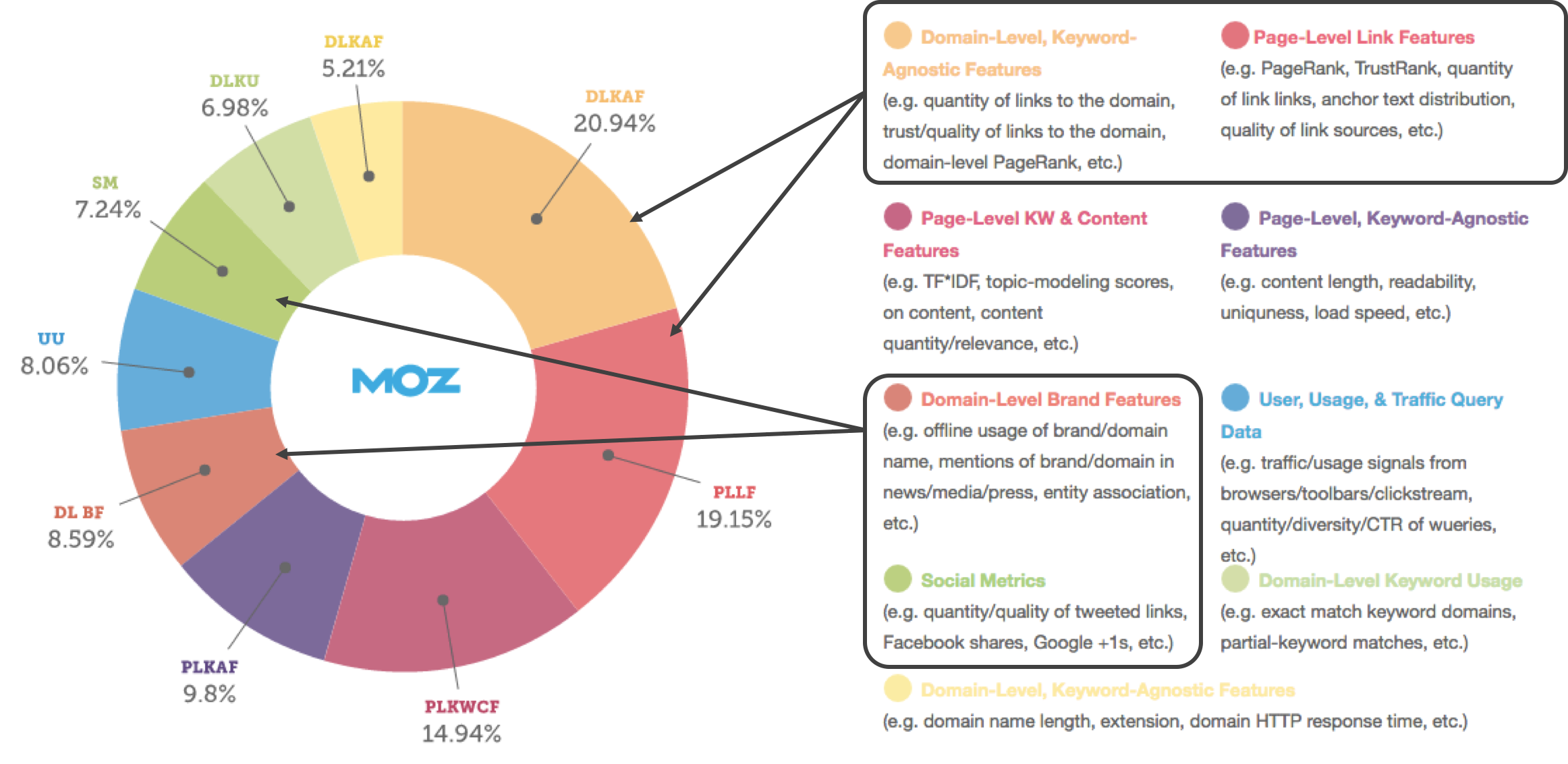
While we don’t know the full algorithm Google uses to rank content, data from our Search Engine Ranking Factors study show that off-site SEO-related factors likely carry more than 50% of the ranking factor weight.
Links and off-site SEO
Building backlinks is at the heart of off-site SEO. Search engines use backlinks as indications of the linked-to content’s quality, so a site with many high value backlinks will usually rank better than an otherwise equal site with fewer backlinks.
There are three main types of links, defined by how they were earned: natural links, manually built links, or self-created links.
- Natural links are editorially given without any action on the part of a page owner. For example, a food blogger adding a link to a post that points toward their favorite produce farms is a natural link.
- Manually built links are acquired through deliberate link-building activities. This includes things like getting customers to link to your website or asking influencers to share your content.
- Self-created links are created by practices such as adding a backlink in an online directory, forum, blog comment signature, or a press release with optimized anchor text. Some self-created link building tactics tend toward black hat SEO and are frowned upon by search engines, so tread lightly here.
Regardless of how links were obtained, those that offer the greatest contribution to SEO efforts are generally those that pass the most equity. There are many signals that positively contribute to the equity passed, such as:
- The linking site’s popularity
- How related the linking site’s topic is to the site being linked to
- The “freshness” of the link
- The anchor text used on the linking site
- The trustworthiness of the linking site
- The number of other links on the linking page
- Authority of the linking domain and page
Non-link-related off-site SEO
While earning links from external websites is the most commonly practiced off-site SEO strategy, almost any activity that a) occurs outside of your own website and b) helps to improve your search ranking position could be thought of as “off-site SEO.” These include things like:
- Social media marketing
- Guest blogging
- Linked and unlinked brand mentions
- Influencer marketing
It’s important to note, though, that the net result of each of these activities is to somehow create a reference to your site from elsewhere on the web — be that reference a link, a mention of your brand or website, or otherwise. So, the concept of truly “non-link-related” off-site SEO is actually a bit of a misnomer!
A note on local off-site SEO:
Off-site SEO relies on human behavior (namely, that people only reference and share content they like). As such, it applies to both organic and local SEO. Even in a brick-and-mortar business, high quality products get a lot of word-of-mouth referrals from current customers — the in-person equivalent of off-site SEO.
How to do off-site SEO
At a high level, improving the “off-site SEO” of a website involves improving search engine and user perception of a site’s quality. This happens by getting links from other sites (especially those that are reputable and trustworthythemselves), mentions of your brand, shares of your content, and “votes of confidence” from sources outside of your own website.
[This post originally appeared on Quora]
Building backlinks takes time and perseverance. You can no longer just throw a link to your site on any site you find. Instead, you need to be thoughtful about where the links come from.
I recommend a few tactics to build backlinks to your website.
1. Write a guest post on a respectable website in your industry or niche. It is common practice for guest bloggers to add a bio with a link back to their site in the blog post. However, don’t reach out to every single blog or website you find in your industry, take the time to make sure it is a good fit for your business. If the website targets a market similar to your own, it is a good bet that not only will you gain a backlink to your site, but you will also reach a new audience.
Additionally, when you are deciding which websites to reach out to, make sure their website has a higher domain authority to yours. This again will be helpful for SEO.
You can even try submitting content to larger businesses and content curators. The Google Analytics blog accepts guest contributors, Huffpost and Business Insider both have an easy to follow process for article submissions, and I’m sure specific websites in your industry also would love a well-written article.
2. Use infographics or shareable media to build backlinks. Readers LOVE diverse media in your content. If you take the time to design a great infographic that contains well-researched data, you may be able to grow your backlinks in no time! Once you have the infographic, write a blog post with more in depth information regarding the stats and data you represent. Then, within the blog post, include a Call to Action to SHARE the infographic from the site and provide the code for someone to copy and paste to their own site. Siegemedia.com has an easy to use embed code generator.
In addition to writing the blog with your call to action to include the infographic on external sites, reach out to influencers in your niche and other websites talking about similar topics to see if they would like to use and share the infographic, as well. Again, these individuals reach a different network than your business, so not only will the backlink be great for SEO, but the new eyes and introduction to your brand will also be beneficial.
3. Find Niche forums. Forums that are very specific to your business and industry can also be great ways to increase backlinks to your site! Many forums do have No Follows, so these links won’t necessarily be great for SEO, they will, however prove useful for directing people to your site. As with all these techniques, make sure you are providing great value rather than just Spamming.
4. Start participating in a Subreddit. Reddit will add a no follow to your links until you post something that gets numerous upvotes. The trick with getting SEO-friendly backlinks on Reddit is to find a subreddit, monitor the discussions, comment and upvote other posts, and then alternate between sharing your links, links of other resources or stories, and commenting and upvoting others’ posts. Users on reddit HATE marketers, so you really need to make sure you are being authentic and useful when you participate.
5. Get interviewed by someone else in your industry. Using the same list you created earlier of influencers in your niche, propose an interview. For other businesses to jump on this, you do need to have authority yourself in the field, but once you do, interviews create a great way to build backlinks and to showcase your expertise.
My number one suggestion as you start building your backlinks it to provide high quality content so you do not come across as SPAM. Best of luck!
If you want to learn more about how to grow your traffic, please join my free email list on digital marketing.

Hello everybody! I’m Caitlin McDonald with Boundless Marketing. Today I want to talk a little bit about SEO or search engine optimization.
Search engine optimization is even more important now than ever has been in the past. The reason is because article creation in general has shifted over the past year or two years. Basically there are so many different players out there, which is phenomenal, but in order to stand out you have to work even harder than you had to in the past. Especially if you’re just starting out, these blogging tips are really going to be helpful as you are making a position for yourself.
I have a couple of tips for you. The first ones we have talked about in the past, but then I’ll go into more detail, as well.
The first tip is that when you are writing those blog posts, don’t shy away from writing longer blog posts. We used to always emphasize splitting longer blogs up between part one, part two, and part three so that in one piece of content you’re going to be linking to different pages. Now it’s actually a lot more important to have longer blog posts. I recommend going up to 5000 words within a single blog post. This is because when you’re really writing that depth about something you’re providing very valuable information to your clients and to your readers.
The next piece is when you’re writing a blog post that this longer, such as 1500 words long, you need to make sure that you’re dividing the content up into different sections. We do this by utilizing heading tags, bullet points, bolded words, etc. Now, heading tags are very easy to implement. Basically, when you’re writing, you’re going through and need to figure out where the obvious divisions are in your content. Are you coming up to a point where you’re going to be talking about five tips to do something, followed by five ways to implement it, and then techniques for follow up? Each of these is a clear division in the content. All you do is you highlight the text, and in the text editor you select the text style for Header 1, Header 2, Header 3 etc.
Which header tag you choose really this depends on how long your content is and how frequently are inserting the breaks in content.
This last piece we haven’t talked about before is using different types of media within your content. Right now, as you can see, I’m doing a video, but I’ll also have the transcript and some images. By creating and including diverse types of media in your blog post, you can help your post rank higher in your industry or in your category for specific keywords.
In general, not every reader is going to learn the same. Somebody who is more into listening and looking rather than reading, is going to be drawn to one type of post rather than another. Additionally, within posts you want to create the images that are going to be shareable. Having those shareable images really helps with the optimization for Instagram, Pinterest, Twitter, Facebook, etc. If you don’t feel comfortable with filming a video you can also do a podcast. That’s another great way to increase the different types of media that you have on the site.
Now the next piece that I recommend doing is sharing all of your information or knowledge as downloadable resources and freebies on your website. I’ll go into more detail in that in a later post, but these tips will point you into the right direction as you’re jumping into using search engine optimization on your blog posts.
![Search Engine Optimization in 2017 [VIDEO] | Blog SEO | Search Engine Optimization in Blogging](http://thebimsteam.com/wp-content/uploads/2017/05/Search-Engine-Optimization-in-2017.png)
Get In Touch
Marketing Tips to your Inbox
Recent Posts
- Crafting a Compelling Digital Message for Your In-Home Care Agency
- Building a Solid Digital Strategy for Home Health Care Agencies
- Leveraging User-Generated Content to Boost Your Brand
- Local SEO Success: Free Strategies to Boost Your Business Visibility & Attract Local Clients
- Mastering the Art of Personal Branding: A Guide to Making Your Mark Online


